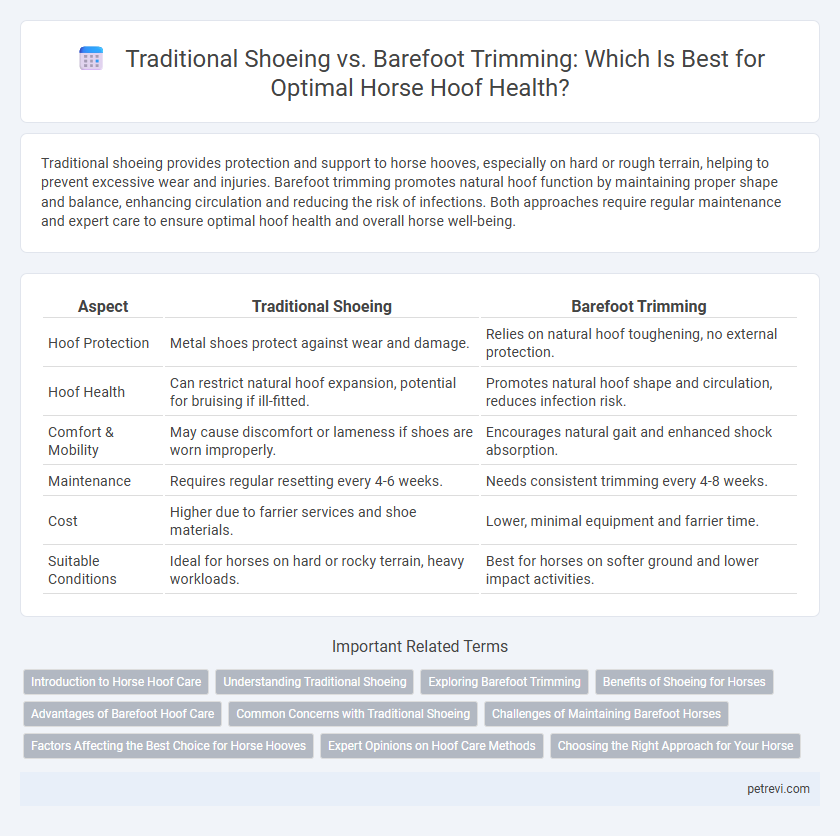Traditional shoeing provides protection and support to horse hooves, especially on hard or rough terrain, helping to prevent excessive wear and injuries. Barefoot trimming promotes natural hoof function by maintaining proper shape and balance, enhancing circulation and reducing the risk of infections. Both approaches require regular maintenance and expert care to ensure optimal hoof health and overall horse well-being.
Table of Comparison
| Aspect | Traditional Shoeing | Barefoot Trimming |
|---|---|---|
| Hoof Protection | Metal shoes protect against wear and damage. | Relies on natural hoof toughening, no external protection. |
| Hoof Health | Can restrict natural hoof expansion, potential for bruising if ill-fitted. | Promotes natural hoof shape and circulation, reduces infection risk. |
| Comfort & Mobility | May cause discomfort or lameness if shoes are worn improperly. | Encourages natural gait and enhanced shock absorption. |
| Maintenance | Requires regular resetting every 4-6 weeks. | Needs consistent trimming every 4-8 weeks. |
| Cost | Higher due to farrier services and shoe materials. | Lower, minimal equipment and farrier time. |
| Suitable Conditions | Ideal for horses on hard or rocky terrain, heavy workloads. | Best for horses on softer ground and lower impact activities. |
Introduction to Horse Hoof Care
Proper horse hoof care is essential for maintaining equine health and performance, involving two primary methods: traditional shoeing and barefoot trimming. Traditional shoeing offers protection and support by applying metal shoes to the hooves, while barefoot trimming emphasizes natural hoof balance and function without shoes. Understanding the benefits and limitations of each approach helps horse owners make informed decisions tailored to their horse's specific needs.
Understanding Traditional Shoeing
Traditional shoeing involves attaching metal horseshoes to the horse's hooves using nails, providing protection and support especially on hard or uneven terrain. This method helps prevent excessive wear, improves traction, and can correct certain hoof or gait abnormalities through custom shoe designs. Understanding traditional shoeing is crucial for managing hoof health in working horses or those frequently ridden on abrasive surfaces.
Exploring Barefoot Trimming
Barefoot trimming promotes natural hoof function by allowing the horse's hooves to wear and grow in a way that mimics wild conditions, reducing the risk of common issues like thrush and laminitis. This method enhances circulation and shock absorption through the hoof's natural mechanisms and supports stronger overall hoof integrity without the constraints of metal shoes. Studies have shown that horses maintained with barefoot trim often exhibit improved hoof conformation and reduced lameness symptoms compared to consistently shod counterparts.
Benefits of Shoeing for Horses
Shoeing provides essential protection and support for horses, particularly those engaged in rigorous activities or working on hard, abrasive surfaces. The metal shoes help prevent excessive hoof wear and reduce the risk of injury, offering enhanced traction and stability. Proper shoeing also aids in correcting gait abnormalities and maintaining overall hoof balance, promoting long-term equine performance and comfort.
Advantages of Barefoot Hoof Care
Barefoot hoof care promotes natural hoof function by allowing the hoof to expand and contract, improving circulation and reducing the risk of common issues like thrush and laminitis. This method encourages the development of stronger, more resilient hoof tissue through regular trimming that mimics natural wear patterns found in wild horses. Horses maintained barefoot often display enhanced shock absorption and better overall limb biomechanics, contributing to long-term soundness and agility.
Common Concerns with Traditional Shoeing
Traditional shoeing often leads to concerns such as restricted natural hoof expansion, increased risk of hoof cracks, and reduced shock absorption. Prolonged use of metal shoes can cause uneven wear and compromise circulation within the hoof capsule. Many horse owners worry about the potential for horseshoe nails to cause pain or infections, challenging overall hoof health and performance.
Challenges of Maintaining Barefoot Horses
Maintaining barefoot horses poses challenges such as increased risk of hoof cracks, sole bruising, and sensitivity on hard or rocky terrain due to lack of protective shoes. Regular, skilled hoof trimming is essential to prevent overgrowth and maintain proper hoof balance, demanding more frequent and specialized care compared to traditional shoeing. Environmental factors and workload variations further complicate barefoot management, requiring adaptive strategies to promote hoof durability and overall horse health.
Factors Affecting the Best Choice for Horse Hooves
Factors affecting the best choice between traditional shoeing and barefoot trimming for horse hooves include the horse's activity level, hoof conformation, and environmental conditions. Horses engaged in high-impact sports or ridden frequently on hard surfaces often benefit from shoes that provide protection and support, while barefoot trimming promotes natural hoof function and may reduce the risk of certain infections in softer or varied terrain. Regular hoof care assessments by a professional farrier or trimmer are essential to determine the optimal approach tailored to the horse's individual health and workload.
Expert Opinions on Hoof Care Methods
Experts in equine podiatry often debate the merits of traditional shoeing versus barefoot trimming, highlighting that shoeing offers protection and support crucial for performance horses on hard terrain. Conversely, barefoot trimming advocates emphasize natural hoof function and improved circulation, pointing to studies where proper trimming mitigates lameness and hoof deformities. Research by organizations like the American Farrier's Association and the Barefoot Coalition underscores that individual horse needs, activity level, and environment should guide hoof care decisions rather than a one-size-fits-all approach.
Choosing the Right Approach for Your Horse
Choosing the right approach for your horse's hoof health depends on factors such as the horse's breed, activity level, and environment. Traditional shoeing provides protection and support for horses used in rigorous work or on hard surfaces, while barefoot trimming promotes natural hoof function and can reduce the risk of infections and injuries. Consulting with an experienced farrier or equine podiatrist ensures a tailored hoof care plan that maintains optimal balance and soundness.
Traditional Shoeing vs Barefoot Trimming for Horse Hoof Health Infographic

 petrevi.com
petrevi.com